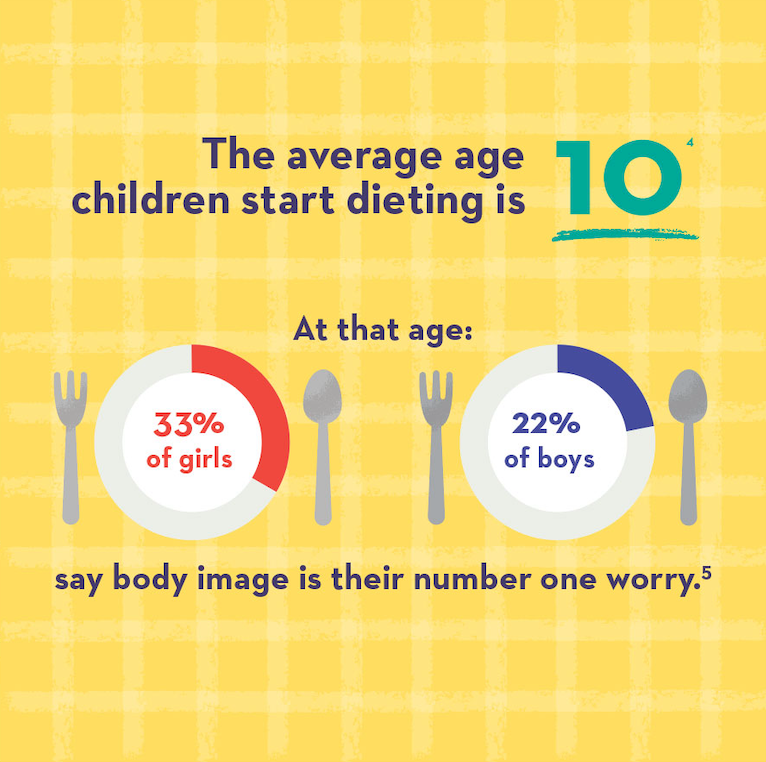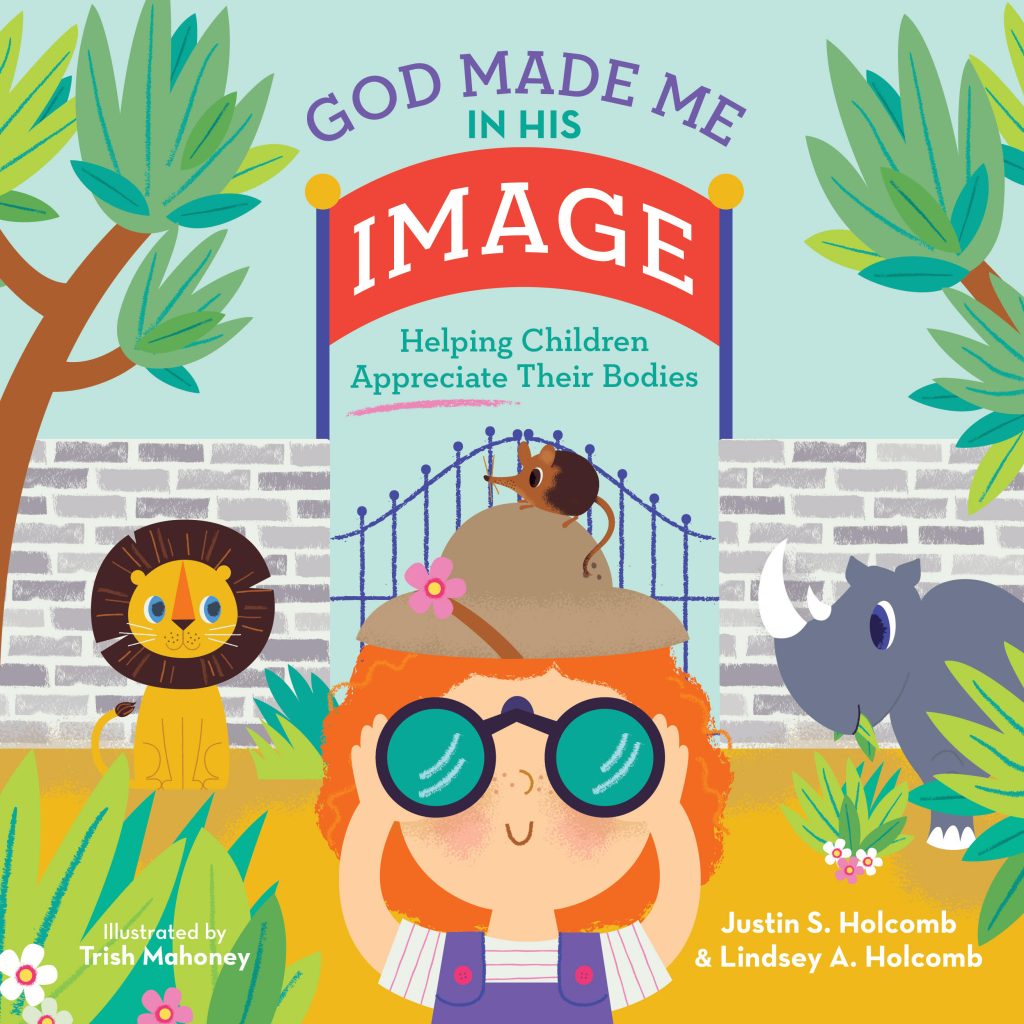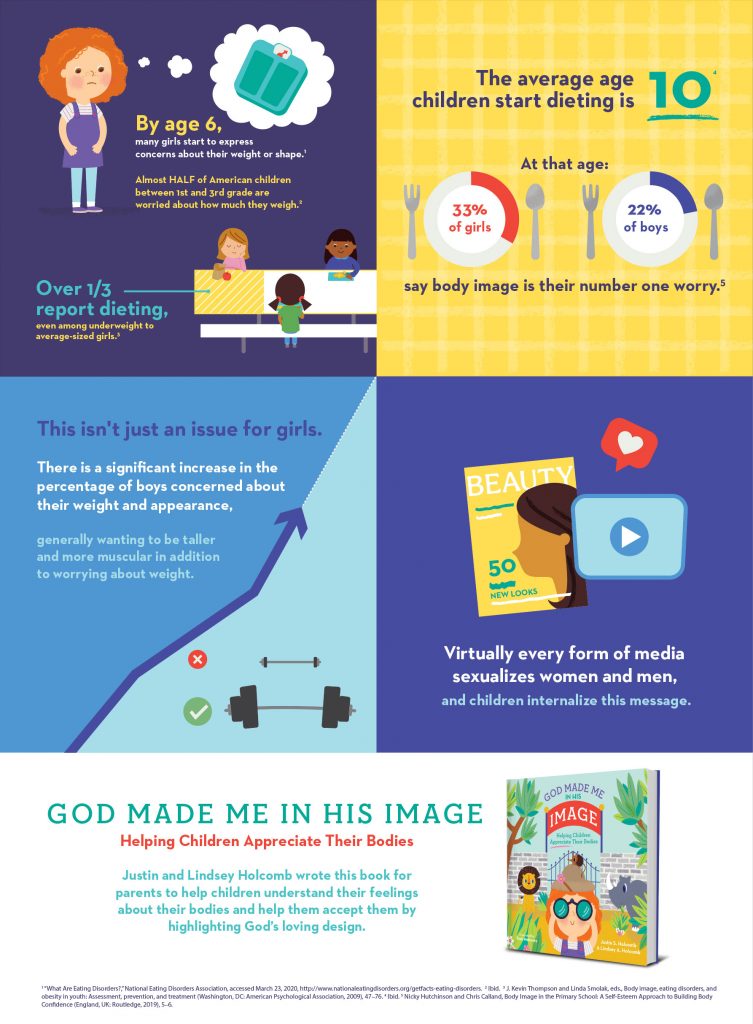
Children and Body Image

In a society overflowing with negative messages about physical appearance and personal worth, children’s body image is an urgent issue. Children need to know God made their bodies and made them special. Parents and caregivers have the privilege and opportunity to help children understand that God crafted them with care and intentionality. This is foundational for shaping an accurate, biblical self-image.
Children need to understand that God made them in his image (Genesis 1:27). Every part of their bodies was designed by God and declared good.
We get to encourage children to appreciate their bodies and come alongside them to address questions and shame they may experience as they absorb prevalent cultural messages about beauty and worth. Statistics regarding children and body issues are staggering and sad. Children are dealing with body-image distortion at an increasingly early age. Many young children are dieting or developing dangerous eating habits in pursuit of the culturally-prescribed “perfect” weight or shape. Additionally, many trends in our culture lead to hypersexualizing of children.
- Five-year-old girls whose mothers reported current or recent dieting were more than twice as likely to have ideas about dieting than girls whose mothers did not diet. A mother’s dieting behavior is a source of her daughter’s ideas, concepts, and beliefs surrounding dieting and body image.[1]
- By age six, girls especially start to express concerns about their weight or shape.[2] Almost half of American children between first and third grade are worried about how much they weigh,[3] and half of nine- to ten-year-old girls are dieting.[4] Approximately 80 percent of all ten-year-old girls have dieted at least once in their lives.[5]Even among underweight to average-sized girls, over one-third report dieting.[6]
- By the age of ten, around one-third of all girls and 22 percent of boys say how their bodies look is their number one worry.[7] Age ten is also the average age when children start dieting.[8] Girls have always shown greater concern about their weight and appearance, but there is a significant increase recently in boys also worrying. Boys want to be tall and muscular—and they worry about weight too.
- Childhood obesity has tripled since the 1980’s.[9]
- Virtually every media form studied provides ample evidence of the sexualization of women and men, including television, music videos, music lyrics, movies, magazines, sports media, video games, the internet, and advertising. Children internalize this message.
Research shows that elementary school age is when children are at risk of developing a poor body-image. By helping to improve their body image at this stage and making them more aware of messages the media is putting out, parents and caregivers can better equip them to be confident about their bodies and their personal worth as children of God.
Encouraging Children to Have a Healthy Body Image
Encourage children not to compare themsleves to their peers. Isntead, help them give thanks to God for the unique gifts he has given them and to ask God how he wants these gifts to be used to share his love and kindness.
If your child has a physical impairment, remind him or her it does not negate their inherent worth as God’s image bearer, nor does it diminish the ways he can shine brightly from their lives.
Encourage your children to invest time into activities and skills they love that are good. Make a list of new things they want to try, learn, or tackle. Spending time on worthwhile activities boosts confidence, builds healthy friendships, and tunes out demeaning messages about ways their size, shape, or other physical features do not fit an artificially prescribed standard. It also reminds them that God gave them their bodies to be used to do good things.
Set a positive example by not criticizing other people’s bodies, clothing, hairstyle, or other features. If children see their parents judging others’ appearances, then they will be much more likely to do the same to others and themselves.
If you have insecurities about your own appeance, don’t make offhand, critical comments about those perceived flaws. Instead, intentionally talk with your children about how God has helped you learn to see your body more like he sees it, even though you still struggle at times. Knowing that you are experiencing the same struggle can help them know what to do with their own pain and insecurities—actively trust the loving Creator who has designed them with care and intentionality.

[1]. Beth A. Abramovitz and Leann L. Burch, “Five-year Old Girls’ Ideas About Dieting are Predicted by Their Mothers’ Dieting,” Journal of the American Dietetic Association 100, no. 10 (October 2000): 1157–1163.
[2]. “What Are Eating Disorders?,” National Eating Disorders Association, accessed March 23, 2020, http://www.nationaleatingdisorders.org/get-facts-eating-disorders.
[3]. Ibid.
[4]. Rate of Eating Disorders in Kids Keeps Rising, US Department of Health and Human Services; Collins, M. E. (1991), “Body figure perceptions and preferences among pre-adolescent children,” International Journal of Eating Disorders, 10(2), 199-208.
[5]. Mellin, L., McNutt, S., Hu, Y., Schreiber, G. B., Crawford, P., Obarzanek, E., “A longitudinal study of the dietary practices of black and white girls 9 and 10 years old at enrollment: The NHLBI growth and health study,” Journal of Adolescent Health 20, no. 1(1997): 27–37.
[6]. J. Kevin Thompson and Linda Smolak, eds., Body image, eating disorders, and obesity in youth: Assessment, prevention, and treatment (Washington, DC: American Psychological Association, 2009), 47–76.
[7]. Nicky Hutchinson and Chris Calland, Body Image in the Primary School: A Self-Esteem Approach to Building Body Confidence (England, UK: Routledge, 2019), 5–6.
[8]. Ibid.; https://www.commonsensemedia.org/research/children-teens-media-and-body-image
[9]. Jennifer Bishop, Rebecca Middendorf, Tori Babin, Wilma Tilson, Childhood Obesity, Assistant Secretary for Planning and Evaluation, US Department of Health and Human Services, updated May 1, 2005, http://aspe.hhs.gov/health/reports/child_obesity/.